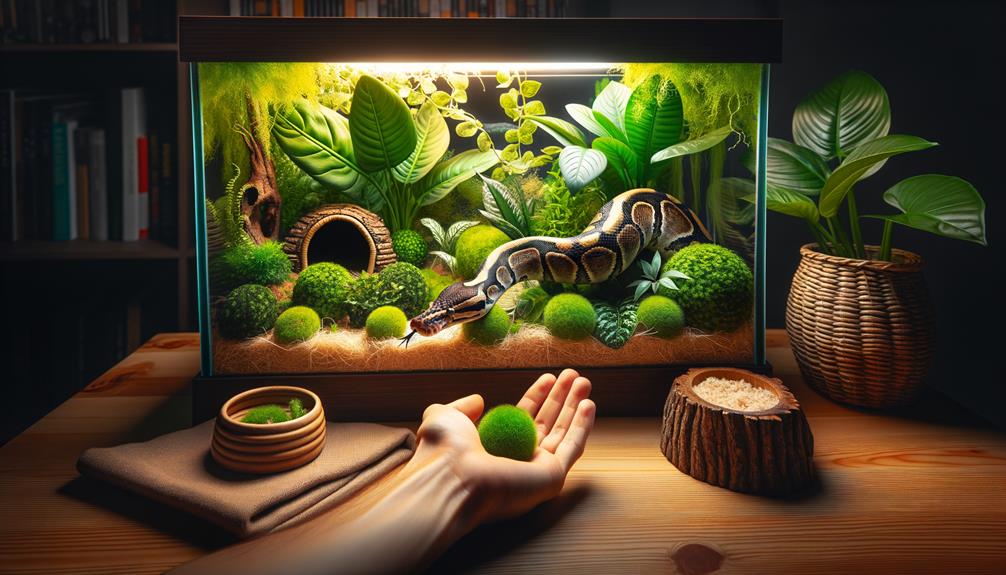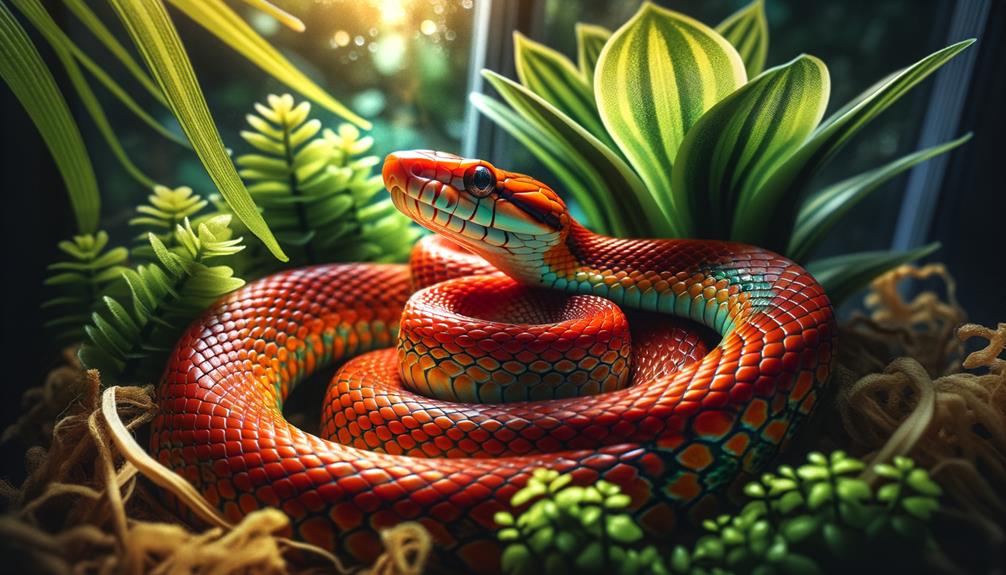I’ve always been fascinated by royal pythons. Their glossy scales come in a variety of colors, perfect for blending in with their surroundings. When threatened, they curl up into a tight ball. You can find them thriving in the grasslands and savannas of West and Central Africa, often hiding in abandoned burrows. They feed on small mammals, birds, and even other snakes. As pets, they’re known for their gentle nature. One of the most striking things about royal pythons is their incredible genetic diversity – there are over 7,500 distinct morphs, showcasing an incredible range of colors and patterns. From their behavior to their genetic diversity, there’s so much more to learn about these captivating creatures.
Key Takeaways
Royal pythons boast an astonishing 7,500 distinct morphs, each featuring unique colors and patterns. When threatened, they curl up into a ball, shielding their vulnerable parts. Their heat-sensing pits and adapted eyes make them formidable ambush predators. Found in the grasslands and savannas of West and Central Africa, royal pythons thrive in their natural habitat. Known for their gentle nature, they’ve become popular pets among enthusiasts.
Unique Physical Traits
Royal pythons boast stunning physical traits that set them apart. Their smooth, glossy scales shimmer in a dazzling array of colors and patterns, ranging from deep browns and blacks to rich golds and creams. This remarkable coloration serves a practical purpose, providing excellent camouflage that helps these snakes blend seamlessly into their surroundings.
When threatened, royal pythons exhibit a unique defense mechanism. Unlike many other snakes, they curl up into a tight ball, tucking their head safely in the center. This behavior not only appears endearing but also protects their most vulnerable parts from potential harm.
As ambush predators, royal pythons rely on their heat-sensing pits, located on their upper lip, to detect prey. These specialized pits allow them to detect the warmth of nearby living creatures, even in complete darkness. Their eyes, well adapted for low-light conditions, further enhance their nocturnal hunting prowess. Despite their impressive predatory skills, royal pythons are known for their gentle nature, making them a popular choice among reptile enthusiasts. These remarkable snakes embody the beauty and adaptability of nature.
Natural Habitat

Royal pythons thrive in the grasslands and savannas of West and Central Africa, where they take shelter in abandoned burrows of small mammals like rodents. These burrows provide a cool and safe environment, shielded from predators and the harsh sun. The natural habitat of these snakes is diverse, ranging from open fields to forest edges, offering them ample opportunity to hunt and hide.
In this part of the world, the grasslands and savannas teem with life, creating a vibrant ecosystem where royal pythons can flourish. They coexist with various other animals, but have carved out a niche for themselves by utilizing the burrows left behind by small mammals. This symbiotic relationship highlights the interconnectedness of the snakes with their environment.
The climate in West and Central Africa is ideal for these pythons, with warm temperatures and seasonal rains that support a rich biodiversity. This natural habitat provides the essentials for their survival and allows them to exhibit their full range of behaviors. Understanding their natural habitat offers valuable insights into the life of these fascinating snakes, emphasizing the importance of preserving these unique ecosystems.
Behavior and Diet

Considering their natural habitat, ball pythons exhibit unique behaviors and dietary preferences that guarantee their survival. These regal creatures, often referred to as royal pythons due to their majestic appearance, have several intriguing characteristics that make them stand out.
One notable behavior is their defense mechanism. When threatened, ball pythons curl up into a tight ball, protecting their head in the center. This behavior not only showcases their unique pattern but also serves as an effective way to deter predators. Their docile nature and adaptability to handling make them popular pets, appreciated for their calm demeanor.
In terms of diet, ball pythons are opportunistic feeders. In the wild, they primarily consume small mammals and rodents. However, their diet can also include birds and occasionally small snakes. Here’s a concise breakdown of their dietary habits:
Small mammals and rodents form the bulk of their diet, providing essential nutrients. Birds are an occasional addition to their meals, offering variety. Small snakes are rarely consumed but part of their diverse diet.
Understanding these behaviors and dietary preferences highlights the ball python’s remarkable adaptability and appeal, both in the wild and as a cherished pet.
Pet Care Tips

To ensure your royal python’s well-being, you need to maintain the right temperature and humidity levels in its enclosure. Aim for a temperature range of 78-80°F on the cool side and 88-92°F on the warm side, mimicking their natural habitat. This temperature gradient allows your python to regulate its body temperature effectively. Humidity is also crucial, with a level of 50-60% helping with shedding and overall health.
Providing multiple hiding spots can help your royal python feel secure. You can use commercially available hides or get creative with natural materials. A secure royal python is a happy one, and reducing stress is key to their well-being.
When handling your python, be gentle and supportive. Limit handling to 1-2 times a week to build trust and minimize stress, avoiding handling during shedding periods. Your royal python will appreciate the break and be less likely to feel discomfort or injury.
Morphs and Genetic Diversity

Among royal pythons, one of the most fascinating aspects is their incredible morph and genetic diversity, boasting over 7,500 distinct morphs that showcase an astonishing array of colors and patterns. The introduction of the first designer morph, the albino, in 1992 sparked an explosion of genetic diversity that continues to fascinate enthusiasts.
The lavender albino is one of the most sought-after morphs, featuring a unique blend of lavender and yellow hues that makes it extremely rare and valuable. This morph demonstrates the remarkable potential of genetic diversity within royal pythons.
Color abnormalities also contribute to the species’ diversity. For instance, some royal pythons exhibit:
- Melanistic: Excessive black pigmentation.
- Albinistic: Lacking melanin, resulting in white and yellow coloring.
- Leucistic: Pure white with blue or black eyes, lacking all pigmentation.
Royal pythons also feature rare and unique morphs like the stormtrooper, which boasts a striking black-and-white appearance. The world of royal python morphs is a reflection of the extraordinary genetic variations that keep both breeders and enthusiasts enthralled.
Frequently Asked Questions
What Are Some Fun Facts About the Royal Python?
I’ve always been fascinated by royal pythons. They curl up into tight balls, can live up to 40 years, and come in a stunning array of colors and patterns. Plus, African rulers once wore them as jewelry, which is pretty cool.
What Are 5 Interesting Facts About Pythons?
I find pythons fascinating! They can grow up to 33 feet in length, kill their prey by constriction, and have specialized heat-sensing organs. What’s more, they exhibit unique parental care, and some even thrive in urban environments. These remarkable creatures have adapted in incredible ways.
What Is Special About a Python Snake?
Pythons are living, breathing works of art, captivating viewers with their intricate patterns and colors. With their gentle nature and knack for controlling rodent populations, they make for fascinating pets and vital members of their ecosystems.
Are Royal Pythons Friendly?
Royal pythons are known for their calm and docile nature, making them a great pet choice. Their manageable size and ability to form strong bonds with their owners through proper care and socialization make them a popular choice among reptile enthusiasts.



